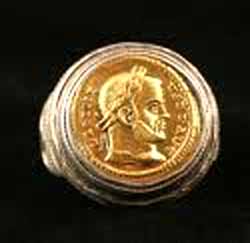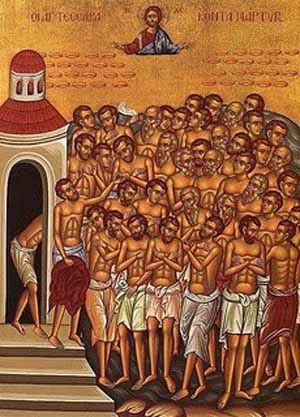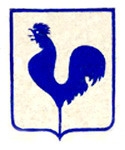 |
Stories & Legends
The Forty Martyrs of Sebaste
& the Baptism of Blood
Fr. Alban Butler
The Emperor Licinius who, at one time, had extended a measure of toleration to the Christians, reversed his policy after his breach with his brother-in-law Constantine, and a fresh persecution was begun. In Cappadocia, where he made some stay, he published a decree, ordering every Christian, on pain of death, to abandon his religion.

Ring with a relief of Emperor Licinius |
When Lysias, the general of the imperial forces, and Agricolaus, the governor of Cappadocia and Lesser Armenia, communicated this decree to the army, 40 young soldiers of various nationalities stationed at Sebaste refused to sacrifice to idols. The 40, who are said to have all belonged to the famous "Thundering Legion," appeared boldly before the tribunal saying that they were Christians and that no torments would ever induce them to forsake their holy religion.
The governor at first tried arguments and persuasion, representing to them the disgrace which would follow upon their refusal to obey and promising promotion and the favor of the Emperor if they would conform. Finding them inexorable, he commanded that they should be cruelly tortured and cast into prison. Here they sang together the 90th Psalm: "He that dwelled in the aid of the Most High shall abide under the protection of the God of Heaven," and they were comforted by a vision of Our Lord who encouraged them to persevere and to win the crown of martyrdom.
A few days later Lysias, their general, came over from Caesarea and strove in vain to shake their constancy.
Then the governor, greatly incensed at their obstinacy, subjected them to a strange ordeal which he himself had devised. The cold in Armenia is very severe, especially in March when the north wind rages. Under the walls of the city stood a pond or lake which was frozen hard, and on it the prisoners were condemned to be exposed quite naked and to be left there night and day.
Agricolaus also ordered that a fire and a warm bath should be prepared on the shore, near the lake, for the reception and restoration of those of the band who could be tempted to purchase temporal ease and safety at the price of apostasy. The martyrs, upon hearing their sentence, ran joyfully to the bank, and, without waiting to be stripped, undressed themselves, encouraging each other and saying that one bad night would purchase for them a happy eternity. Together they prayed "Lord, we are 40 who are engaged in this conflict: grant that 40 may be crowned and that we may not fall short of that sacred number."

At left, as one of the soldiers apostatizes, the sentinel disrobes to join the 40 martyrs |
Their guards were continually urging them to offer up sacrifice and so to pass on to the fire and the warm bath, but all in vain. St. Gregory of Nyssa asserts that they endured for three days and three nights this lingering death. It is not easy for us to form any idea of the agony they endured, but, out of the whole number, only one failed and allowed himself to be led away to the shore. As it turned out, the reaction of the heat after the intense cold was too great and he expired in the bath, thus losing the life he had striven to save as well as the palm of victory.
This defection greatly grieved the martyrs, but they were soon consoled by seeing his place filled and their number miraculously completed.
One of the soldiers who had been set to guard the prisoners, being off duty, sat down to warm himself by the fire, and as he rested he fell asleep and had a dream. He seemed to be standing by the lake when suddenly the sky was filled with beautiful angelic forms. One by one they descended upon the ice bearing robes and crowns with which they invested the martyrs. The soldier counted: there were 39 crowns. This vision and the desertion and fate of the apostate wrought his instantaneous conversion.
By a special inspiration of the Holy Ghost, he flung off his clothes, stepped on to the ice, and took his place among the survivors, proclaiming himself a Christian. By his martyrdom he obtained the grace of what is known as the "baptism of blood" as well as the 40th crown which had been forfeited by the deserter. God had indeed heard the petition of His servants and had answered it in this wholly unexpected way.
(To read more on the continuation of this story and how Melito, one of the soldiers, was encouraged by his mother to follow the example of his fellow martyrs, click here)

Alban Butler, The Life of the Saints,
New York: Kenedy & Sons, 1932, vol. 3, pp. 161-162.
Posted September 25, 2010


Related Topics of Interest
 The Forty Martyrs of Sebaste The Forty Martyrs of Sebaste
 St. Sebastian, Soldier and Martyr St. Sebastian, Soldier and Martyr
 The Martyrs of Japan The Martyrs of Japan
 New Vatican Norms for Establishing Martyrs New Vatican Norms for Establishing Martyrs
 The Heroism of St. Marciana, Martyr The Heroism of St. Marciana, Martyr
 A Saint Factory: Was Maximilian Kolbe a Martyr? A Saint Factory: Was Maximilian Kolbe a Martyr?
 New Saints, A Lack of Consistency New Saints, A Lack of Consistency

Related Works of Interest
| |
|
Legends | Religious |
Home | Books | CDs | Search | Contact Us | Donate

© 2002-
Tradition in Action, Inc. All Rights Reserved
|
 |
|